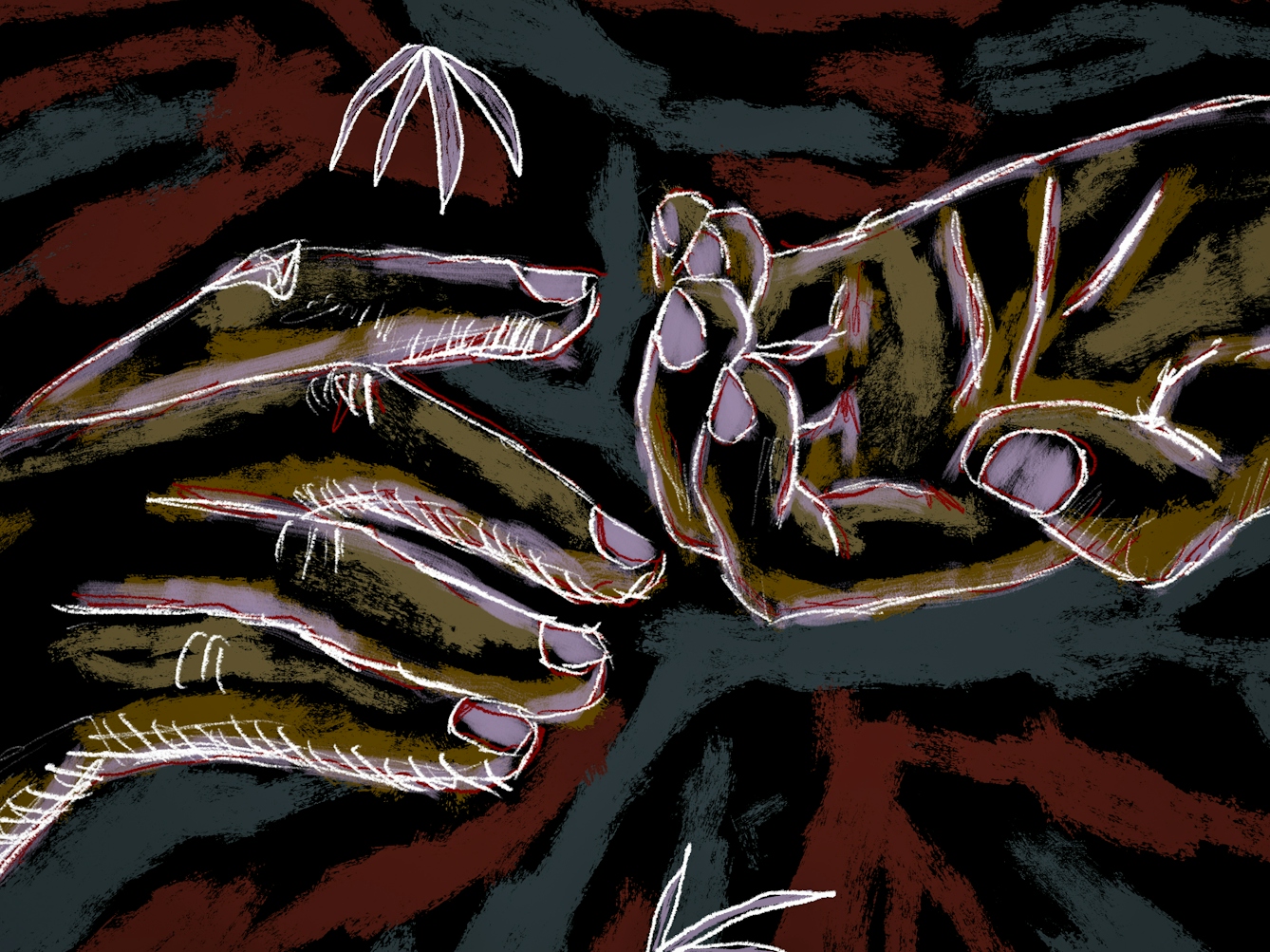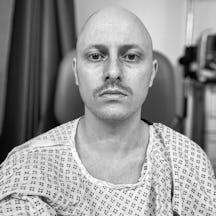As a young adult, Scott Neill was depressed and self-destructing, plastering over heartbreak with whatever vice he could. Then, suddenly, he became seriously ill and nearly died. The experience was agonising but enlightening. Scott’s life had changed: surviving a flesh-eating disease had given him a chance to start again.
Surviving a flesh-eating disease
Words by Scott Neillartwork by Nan Carreiraaverage reading time 5 minutes
- Article

When I was growing up, people often quipped, “If we can survive this, then we can survive anything!” It was an expression I heard time and again from the matriarchs in my life, one that accompanied us through divorce, death and depression. But it wasn’t until I developed necrotising fasciitis that I understood what survival truly meant.
My late teens and 20s were hard, shaped by loss. When was 18, I watched my father decay into a grey stranger as I sat with him through his various chemotherapy treatments. On the drive back to his house, we’d often have to pull over so he could vomit. I can still smell the sweet, medicinal scent that he emitted.
Dad passed away a week before Christmas and his funeral was held on 23 December, on a day blistered in snow and ice. It was so cold that the bagpiper’s lips and fingers struggled to play ‘Flower of Scotland’.
At 24, I lost one of my best friends to an accidental drug overdose and, two years later, I lost my nan. She was the rock of our working-class sea-town family, and without her, we were left anchorless.
By 27, I had lost all sense of self and was diagnosed with depression. The medication numbed me beyond recognition. During this dark time, my two-year relationship ended quite suddenly and the process of moving on felt impossible. Heartbroken, I came dangerously close to ending my own life.
Then, a month after turning 30, a small graze on my knee changed my life.
Otherwise known as the “flesh-eating disease”, necrotising fasciitis is a rare but deadly bacterial infection that affects the fascia and muscles under the skin. It spreads quickly and kills the tissue as it does. That small graze let streptococcus bacteria in, and I’m so glad that it did.
Why would a deadly infection that kills one person in three be something I’d be glad to have had? I’ve asked myself this so many times and I keep coming up with the same answer: I survived.

“I felt completely alien in my own body.”
Growth and recovery
From passing out in A & E due to inexplicable pain emanating from my knee, to the crying, and all the unknowns – there are so many traumatic moments from those six weeks in the hospital that mean I now approach every day with pure gratitude.
I experienced excruciating exploratory needle drains under my kneecap, with surgeons telling me they needed to cut away as much muscle as possible to stop the spread, and that I was a couple of hours from potentially losing my leg or even dying.
I saw my exposed leg muscles and tendons, and I watched fluids draining out of me in pipes. I witnessed my latissimus dorsi muscle being removed to cover my knee, then later watched it fail and decay. I endured endless pain, multiple skin grafts, blood transfusions, anaemia, and had to be hooked up to a catheter and morphine constantly.
I felt completely alien in my own body.
From the same ward I’d watched my nan die in, I heard the helplessness in my mum’s cries. I was left wondering whether amputation was a better option, realising my mobility might be permanently altered.
During my hospital stay, I became acquainted with an eloquent farmer who lay in the bed opposite. I heard him call me “stoic” on the phone to his family. But all I could do was accept everything for what it was.
There are so many traumatic moments from those six weeks in the hospital that mean I now approach every day with pure gratitude.
I somehow knew that, on the other side, there would be immense growth and discovery. I felt that my life had been building up to this moment and I was finally being given a chance to change it. There was no mysticism, no superpower. I embraced it all with open arms. I let it wash over me.
The hardening process of steel involves three phases. Firstly, it must be heated in fire to its critical point, where the chemical composition of the material changes. After heating, it is rapidly submerged in a liquid to bring down the temperature, but in doing so it becomes incredibly brittle. The final process, after such extreme conditions, is where it is tempered to a point where it becomes stable, hardy and durable – ready for its purpose.
There are so many people I owe a great deal of gratitude to. The people who have tempered me in the aftermath of my extreme condition. My mum, my sister, family, friends, strangers, nurses, doctors, surgeons. It’s an overwhelming feeling to be indebted to so many people and know that there is pure goodness all around.
Life is short. Life is fragile. I have no more time to waste.
I survived this and I can survive anything.
About the contributors
Scott Neill
Scott Neill is a musician, DJ and creative from Swansea. He has spent the past decade in a touring punk band, working as a lighting engineer in a music venue hosting the likes of Stormzy and Lower Than Atlantis, and DJing a hugely popular funk/disco night for students. He lives to create, and loves to curate vibrant and memorable experiences.
Nan Carreira
Nan Carreira is a non-binary artist working primarily with painting, drawing and participative art, with a special focus on queerness. Nan’s work can be seen as a call to imagine new worlds where traits like vulnerability and self-expression are celebrated instead of being punished and repressed.

